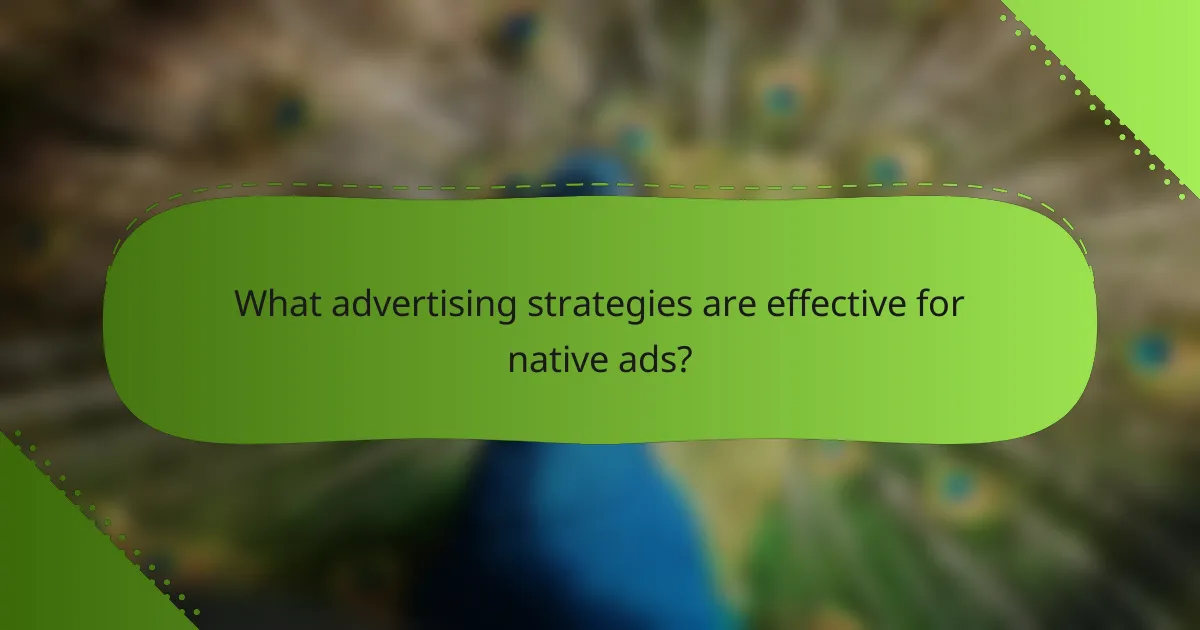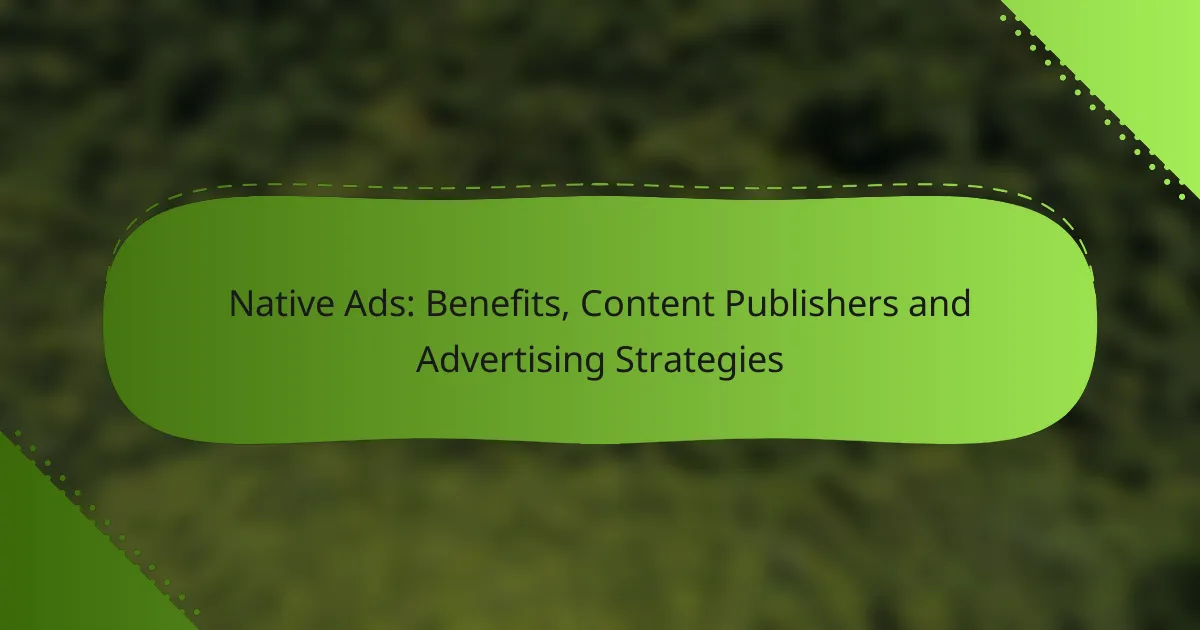Native ads have emerged as a powerful tool for advertisers, offering benefits such as higher engagement and improved brand perception by blending seamlessly with surrounding content. Content publishers utilize native ads to enhance user experience and generate revenue, maintaining audience trust while providing effective visibility for brands. Successful advertising strategies prioritize seamless integration, engaging storytelling, and precise targeting to maximize both user engagement and conversion rates.

What are the benefits of native ads?
Native ads offer several advantages, including higher engagement and improved brand perception. They blend seamlessly with the content, making them less intrusive and more appealing to users.
Higher engagement rates
Native ads typically achieve higher engagement rates compared to traditional display ads. This is largely because they match the form and function of the surrounding content, capturing user attention more effectively. Brands can see engagement rates that are several times higher than standard banner ads.
To maximize engagement, ensure that the native ad content is relevant to the audience and aligns with the platform’s style. Tailoring the message to fit the context can significantly enhance user interaction.
Improved brand perception
When executed well, native ads can enhance brand perception by presenting the brand in a positive light. Users often view native ads as more trustworthy since they provide valuable information rather than overt promotional messages. This can lead to a stronger emotional connection with the audience.
Brands should focus on creating high-quality, informative content that resonates with their target demographic. Consistency in messaging and aesthetics across platforms further strengthens brand identity.
Seamless user experience
Native ads contribute to a seamless user experience by integrating naturally into the content users are already consuming. This reduces the likelihood of ad fatigue and improves overall satisfaction with the platform. Users are less likely to feel interrupted or annoyed by ads that feel like part of the content.
To ensure a seamless experience, maintain a balance between promotional content and user-centric information. Avoid overly aggressive calls to action that could disrupt the flow of content consumption.
Increased conversion rates
Native ads can lead to increased conversion rates due to their engaging nature and relevance. When users find the content appealing and informative, they are more likely to take action, such as clicking through to a website or making a purchase. Reports suggest that conversion rates can improve significantly when using native advertising strategies.
To boost conversions, focus on clear, compelling calls to action and ensure that the landing pages are optimized for user experience. A/B testing different ad formats can help identify what resonates best with your audience.
Enhanced targeting capabilities
Native ads allow for enhanced targeting capabilities, enabling brands to reach specific demographics effectively. Advertisers can utilize data analytics to tailor their messages based on user behavior, interests, and location, ensuring that the right audience sees the right content.
Utilizing tools like programmatic advertising can streamline the targeting process. Regularly reviewing and adjusting targeting parameters based on performance metrics will help optimize ad spend and improve results over time.

How do content publishers leverage native ads?
Content publishers leverage native ads by seamlessly integrating promotional content into their platforms, enhancing user experience while generating revenue. This approach allows them to maintain audience engagement and trust while providing advertisers with effective visibility.
Integrating ads into editorial content
Integrating native ads into editorial content involves creating advertisements that match the look and feel of the surrounding material. This can include sponsored articles, videos, or social media posts that align with the publisher’s voice and style. For instance, a lifestyle blog might feature a product review that reads like a regular post, making it less intrusive for readers.
Publishers should ensure that the native ads are clearly marked as sponsored to comply with advertising standards and maintain transparency with their audience. This practice helps avoid misleading readers while still delivering valuable content.
Utilizing sponsored content platforms
Sponsored content platforms allow publishers to distribute native ads across multiple channels efficiently. These platforms connect publishers with advertisers looking to promote their products or services through engaging content. Examples include Taboola and Outbrain, which help publishers monetize their traffic by recommending sponsored articles to their audience.
When using these platforms, publishers should carefully select the types of content they promote to ensure alignment with their brand and audience interests. This targeted approach can enhance user engagement and improve ad performance.
Building partnerships with advertisers
Building partnerships with advertisers is crucial for content publishers to create effective native ads. These collaborations can lead to customized campaigns that resonate with the publisher’s audience, increasing the likelihood of engagement. Publishers should seek long-term relationships with brands that share similar values and target demographics.
Effective communication and collaboration can result in tailored content that meets both the advertiser’s goals and the publisher’s standards. Publishers should also consider offering performance metrics to advertisers, demonstrating the value of their partnerships and fostering trust.

What advertising strategies are effective for native ads?
Effective advertising strategies for native ads focus on seamless integration with content, engaging storytelling, and precise targeting. These strategies enhance user experience while maximizing engagement and conversion rates.
Storytelling approaches
Storytelling is a powerful approach in native advertising, as it captivates the audience and fosters a connection with the brand. By weaving narratives that resonate with the target demographic, advertisers can create compelling content that feels less like an ad and more like a valuable story.
Consider using relatable characters and scenarios that reflect the audience’s experiences. For example, a fitness brand might share a success story of a customer who achieved their goals using the product, making the ad more relatable and engaging.
Data-driven targeting
Data-driven targeting involves utilizing analytics to identify and reach specific audience segments effectively. By analyzing user behavior, demographics, and preferences, advertisers can tailor their native ads to meet the interests of their audience, increasing the likelihood of engagement.
Employ tools that track user interactions and gather insights to refine targeting strategies. For instance, using A/B testing can help determine which content performs better, allowing for adjustments that enhance effectiveness.
Multi-platform distribution
Multi-platform distribution is essential for maximizing the reach of native ads. By deploying content across various platforms—such as social media, websites, and mobile apps—advertisers can engage users where they spend their time, increasing visibility and interaction.
Consider the unique characteristics of each platform when creating native ads. For example, a visually appealing ad may perform well on Instagram, while a more informative piece might be better suited for LinkedIn. Tailoring content to fit the platform enhances user experience and effectiveness.

What are the best practices for creating native ads?
Effective native ads seamlessly blend with the surrounding content while delivering a clear message. To create impactful native ads, focus on audience alignment, transparency, and mobile optimization.
Aligning with audience interests
Native ads should resonate with the interests and preferences of the target audience. Conduct thorough research to understand what content engages your audience, including their demographics, behaviors, and preferences.
Utilize data analytics and audience insights to tailor your native ads. For example, if your audience is interested in health and wellness, create ads that provide valuable information or solutions related to that topic.
Maintaining transparency with disclosures
Transparency is crucial in native advertising to maintain trust with your audience. Clearly disclose when content is sponsored or paid, using phrases like “Sponsored” or “Paid Content” to distinguish ads from editorial content.
Adhering to guidelines set by advertising standards organizations can help ensure compliance. This transparency not only builds credibility but also enhances user experience by setting clear expectations.
Optimizing for mobile devices
With a significant portion of users accessing content on mobile devices, optimizing native ads for mobile is essential. Ensure that your ads are responsive and visually appealing on smaller screens, maintaining readability and engagement.
Consider using shorter text and eye-catching visuals to capture attention quickly. Testing different formats and placements can help determine what works best for mobile users, enhancing overall performance.

What metrics should be tracked for native ad performance?
To evaluate native ad performance, key metrics include engagement rates, click-through rates (CTR), and conversion rates. These metrics provide insights into how well the ads resonate with the audience and drive desired actions.
Engagement Rates
Engagement rates measure how users interact with native ads, including likes, shares, and comments. A higher engagement rate indicates that the content is appealing and relevant to the audience. Aim for engagement rates above 1% as a benchmark for effective native advertising.
Click-Through Rates (CTR)
Click-through rates (CTR) reflect the percentage of users who click on the ad after viewing it. A typical CTR for native ads ranges from 0.5% to 3%. Monitoring CTR helps assess the effectiveness of the ad’s placement and messaging.
Conversion Rates
Conversion rates indicate the percentage of users who complete a desired action after clicking on the ad, such as making a purchase or signing up for a newsletter. Effective native ads often achieve conversion rates between 2% and 10%. Tracking this metric helps determine the overall success of the advertising strategy.
